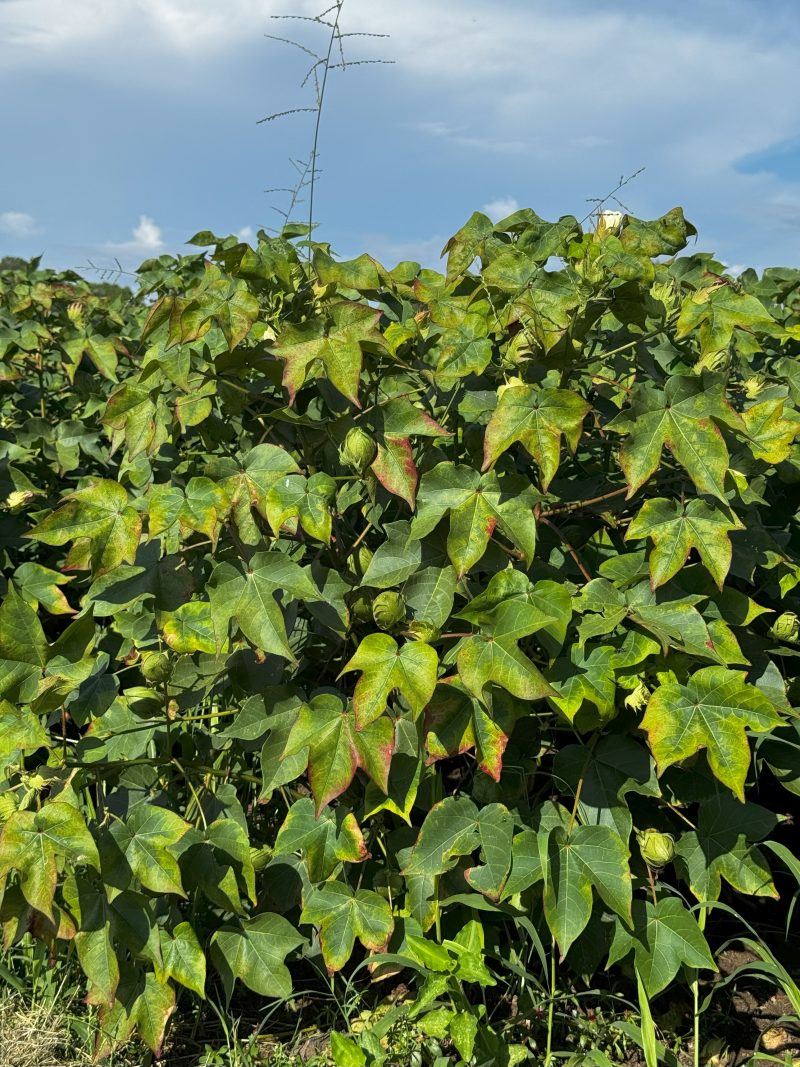Isaac Esquivel, UF/IFAS Crop Entomologist, Scott Graham, Alabama Crop Extension Specialist, Phillip Roberts, Georgia Extension Crop Entomologist, and Jeremy Greene, Clemson Crop Entomologist

Figure 1. Adult two-spot Cotton Leafhopper. It can be identified by two black spots on the wings and head. Photo by: I.L.Esquivel, UF/IFAS (Click on image for full screen viewing)
A couple of weeks ago, I shared that the Two-spotted cotton leafhopper (Amrasca biguttula), aka Cotton Jassid, was moving into cotton fields, and we were uncertain about what it would do. It has since spread across the Southeast, causing significant injury in fields with high populations. They were first detected on cotton in Gilchrist County, Florida, on July 3rd, where adults and nymphs were present, suggesting they had been there for at least two weeks. The following week, adults were detected at the NFREC in Quincy. Since then, they have been detected in at least 50 counties across Alabama, Florida, Georgia, and South Carolina.
–
Identification and Plant Injury
Two-spotted cotton leafhoppers (Jassids) are small, pale green insects with yellowish-green wings. They can be distinguished from most native species in North America by the pair of black spots on the head and black spots at the tip of each wing (Figure 1).

Figure 2. Early hopper burn symptoms due to two-spotted cotton leafhopper (Cotton Jassid) feeding. Photo by: I.L.Esquivel (Click on image for full screen viewing)
Like other leafhoppers, they feed on cell contents and are often found on the lower surface of leaves. In cotton, high populations can produce a ‘hopperburn’ effect characterized by yellowing, reddening, and browning of the leaves (Figure 2). Initial injury symptoms can look like a nutrient deficiency with slight yellowing along the leaf tips and margins. Another symptom is an upward curling/cupping of the leaves. Once early symptoms are visible, leaves decline rapidly, turning red and brown. Late-stage hopper burn can resemble a spider mite infestation, so it is crucial to double-check before attempting to control spider mites.
–
Preliminary Threshold, Scouting, and Control
When scouting a field for Jassid, count nymphs on the 3rd, 4th, or 5th mainstem below the terminal. Sample a minimum of 25 leaves across plants and average counts across the number of leaves sampled. Our preliminary threshold has been moved down to 2 Jassid nymphs per leaf. In terms of management, multiple products seem to provide good efficacy. Bidrin (6 oz/a) has been consistent in multiple trials across FL, GA, and SC, but may be difficult if whiteflies are an issue. Centric (2 oz/a) and Transform (1.5 oz/a) seem to be consistent as well. One product that should not be used is Bifenthrin, which has proven not to be effective across multiple trials. For more details on identification and trial data across the Southeast, use the following link:
Two-Spotted Cotton Leafhopper ‘Jassid’ Update
–
The situation is changing weekly, so recommendations are likely to change. We are also interested in the distribution of this pest in cotton across the Panhandle and Southeast. If you have any questions or concerns about management, or if you have an infestation, please reach out to us: (Isaac.Esquivel@ufl.edu, Office: 850-875-7146), Regional Crop IPM Agent Ethan Carter (ethancarter@ufl.edu, 850-482-9620), or your local county agent.
